Six students from the University of Yangon analyze key themes in the military-controlled and state-owned media since the February 1st coup.
On 1st February 2021, the Myanmar military staged a coup d’etat, declaring a State of Emergency and detaining State Counsellor Daw Aung San Suu Kyi, President U Win Myint, elected members of parliaments, and other politicians. Most cabinet ministers have been replaced with military-backed State Administration Council (SAC) appointees. Chit Naing (Psychology), a former writer (some Burmese writers use their discipline or university to distinguish themselves), has become the Minister of Information or, in other words, the person responsible for the dissemination of propaganda through state-owned media.
From the Merriam Webster Dictionary, one definition of propaganda is “ideas, facts, or allegations spread deliberately to further one’s cause.” This research article analyses various propaganda found on television channels (broadcast media), social media platforms, and in print media (i.e., newspapers), from February 1-11, 2021, with a qualitative approach.
Since this article is just a preliminary analysis, specific gaps in the literature may still need to be filled. In addition to the media platforms and sources mentioned in this research, this study could be more far-reaching if other material was taken into consideration, including: state-owned (currently controlled by the military) radio channels; February and March issues of Myawaddy and Ngwe-tar-yi magazines published by Myawaddy Publishing House; the military-associated Pyidaungsu and Yadanarpon daily newspapers; and fake news intentionally spread on social media.
Following the coup, the Myawaddy (MWD) and MRTV channels have become primary sources of propaganda related to issues of religion, ethnicity, the development sector, and the suppression of the Civil Disobedience Movement (CDM). Both channels are streaming online via Youtube, with MRTV’s content including official statements and orders, primarily. The MWD channel consists of video clips (at an average of 30 minutes long) that highlight footage of senior officials’ charitable donations to monks, nuns, monasteries, as well as footage of officials visiting pagodas.
Entertainment programs on these channels mainly consist of military-sponsored songs and movies. “Pyi Htaung Su Thit Sar” (“Union Oath”) has been broadcast repeatedly. This movie emphasizes the military’s role in establishing nationwide peace and stability and describes Ethnic Armed Organizations (EAOs) as insurgent or “terrorist” groups. In that “Union Oath” tries to awaken nationalism by highlighting the military’s role, it can be considered as a typical example of “flag-waving” propaganda.
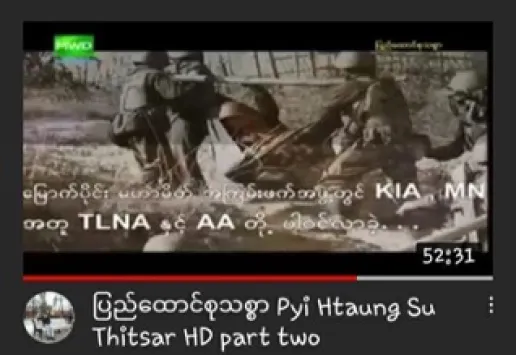
Following the coup, the channels also broadcast videos of military personnel and soldiers sharing commodities with the poor, including interviews with the recipients who show gratitude, thereby leading the audience to perceive the soldiers as humane, religious, and moralistic people. This can also be considered as a Flag-waving propaganda technique. Meanwhile, the channels broadcast footage showing military doctors, nurses, and surgeons performing operations in military hospitals, including scenes of patients expressing gratitude towards the military.
Another statement titled “Request to the Public” was issued on February 8 and mentioned that some civil servants have failed to perform their duties due to unscrupulous persons’ incitement. It also noted that the “unscrupulous” people are threatening the public with an “excuse” of democratic rights. Far from being “excuses,” the rights to freedom of expression, association, and peaceful assembly are protected under international law and are considered essential to a democratic society’s functioning.
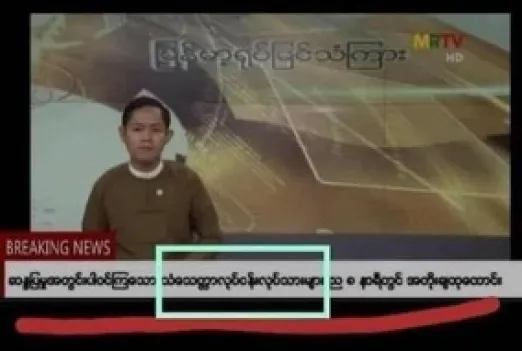
The widespread anti-coup “Pots and pans campaign” was labeled as “noises from tinsmith craftsmen” by MRTV news. The channels also tried to misinform the public by broadcasting selected scenes of people relaxing in public parks and of schools reopening. The military junta has promised to enhance the development of rural areas and the broader process of national development. This includes a promise to reopen factories that were shut down due to the COVID-19 pandemic and commitments to handle Myanmar’s economic decline. On February 8, MRTV broadcasted news of Senior General Min Aung Hlaing’s meeting with the Union of Myanmar Federation of Chamber of Commerce and Industry (UMFCCI) and his instructions to implement the process of re-opening. The junta’s intention to gain public support through performance-based legitimacy has become apparent through their media releases.
The junta’s method of propaganda also involves rewarding the public with incentives. According to the news aired by MWD on 7th February, a transportation project was launched in rural Magway District to provide for civilians’ social well-being. In Senior General Min Aung Hlaing’s speech on 8th February, he mentioned that the junta would give its best effort to creating job opportunities.
Senior General Min Aung Hlaing also requested that the government staff who joined the Civil Disobedience Movement should get back to work, stating that civil servants’ cooperation is necessary for the country to run. The motive behind his appealing words, which emphasized the importance of government staff, is ultimately to ensure the functioning of the regime’s bureaucratic mechanism.
February 8 and 11 saw speeches by Senior General Min Aung Hlaing, each broadcasted at least three times within two consecutive days. In these speeches, Min Aung Hlaing emphasized election fraud and the 2008 Constitution, which can be seen as a part of the regime’s effort to gain legitimacy. Mentioning the fact that there will be no change in foreign policy and that the military will continue establishing friendly relations with all countries, the regime has tried to gain the recognition of the international community. Phrases such as “people are the parents,” “no one is above the law,” “multi-party democratic system,” and “genuine and disciplined multi-party democratic system” were repeatedly used, and the military junta is therefore, pretending as if its actions adhere to democratic norms. The repetitive slogans and phrases such as “unity is strength,” “eternal peace,” “esteemed national, ethnic people,” and “national people” indicate that the military is seeking the support of various ethnic political parties as well as the people living in the different corners of the country.
According to the fifth point of the Road Map introduced by Min Aung Hlaing in his first speech, it was stated that the 2008 Constitution emerged out of constitutional conventions that took many years and required the efforts of over 700 representatives from many different strata of life to build a multi-party democratic system. However, the 2008 Constitution severely limits democratic engagement, providing enormous power to the military and legitimizing the military’s interference in politics. Because it cannot rely on democratic legitimacy, the military junta is constantly trying to reaffirm the legitimacy of its regime on other grounds while also giving frequent warnings that any person or any movement acting against its orders will be punished.
The military has also been using social media platform pages such as the official military Facebook page, “Tatmadaw True News Information Team,” and the military-associated “People Media” since the beginning of February 2021. While these pages have since been taken down in line with Facebook’s global policies prohibiting incitement of violence, their primary use has been to distribute propaganda and drive confusion among Myanmar citizens mainly in three areas: religion, the healthcare sector, and the Civil Disobedience Movement.
Analysing the distribution of propaganda based on religion, we note that Senior General Min Aung Hlaing has moved to reopen pagodas and other religious buildings across the country (closed according to the COVID-19 prevention and control measures) several times in his speeches starting from February 2, and has appeared publicly visiting well-known Buddhist monks in Nay Pyi Taw. He has also noted that the military junta will continue to promote and propagate the Śāsana and increase donations to places in need. With the military junta constantly bringing up religion in all of its speeches and news, we conclude that this is another modified example of flag-waving propaganda that enhances nationalism and patriotism through the inclusion of religion.
More specifically, the junta has spread misleading news of citizens’ peaceful visit to pagodas and of high-ranking military officials’ efforts in promoting the Śāsana, at least once a day since the reopening day of pagodas on February 8, 2021. One post published on February 10 at 7:48 pm, on the Tatmadaw True News Information Team Facebook page, featured a headline about moving a large Buddha statue and other related items to Naypyidaw. Another post was published on the same day at 10:05 pm, then again on February 10 and 11 at 7:48 pm and 9:21 pm, respectively, with the caption: “Citizens are peacefully visiting the Shwedagon Pagoda and other pagodas in respective regions and states.” The portrayal of “business as usual” with regard to religious practice is intended to downplay protest movements.
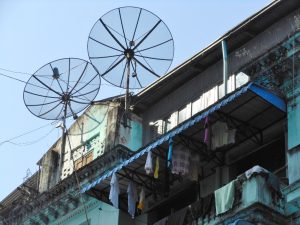
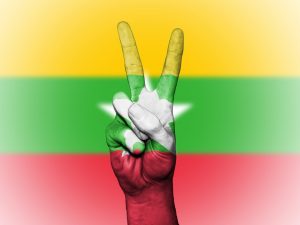
3 Minutes To Read
April 12, 2018
Exploring the distribution of propaganda related to health care services, the junta has been highlighting military medics’ ability to continuously provide health care access to the citizens, despite the situation on-the-ground where even public doctors have joined other striking medical workers. As a consequence, we see the junta’s propaganda as mobilizing the health care sector as a means of achieving public trust and underscoring the public’s dependency on military hospitals and medics.
Posts published on the Tatmadaw True News Information Team Facebook page align with this interpretation. A post on February 8, 1:21 pm was titled “Citizens received necessary health care services in military hospitals and in temporary health centers and refreshments were provided.” On February 9, 9:11 pm, another post read, “Military hospitals welcomed patients from various states and regions and delivered health care services.” A third published on February 10, 8:24 pm stated “Military hospitals welcomed patients from various states and regions and delivered health care services, with public doctors volunteering to join the services.” Lastly, on 11 February 5:08 pm, the Tatmadaw True News Information Team Facebook page issued Senior General Min Aung Hlaing’s speech, mentioning that new plans were being set to vaccinate all Myanmar citizens including monks. The plans were to issue permits for the FDA approved COVID-19 vaccines, to allow the import of more effective vaccines, and to welcome individuals’ requests for vaccination. He then continued to ask that the civil servants who refused to go to work not prioritise their feelings, requesting that they get back to their respective jobs for the sake of Myanmar’s citizens.
Moreover, with the number of citizens participating in the Civil Disobedience Movement increasing every day, the distribution of anti-CDM propaganda has spread to all military-owned media and platforms. Senior General Min Aung Hlaing mentioned in a speech that citizens who are encouraging civil servants to participate in the movement are “unscrupulous people.” On February 2, after civilian doctors started the Movement, the military-owned media published a statement by Senior General Min Aung Hlaing accusing the civilian doctors of betraying the oath they had sworn as physicians and that, because of this, the military medical officers had taken in patients, treating them with compassion, no matter their social status, religion or ethnicity. This propaganda has attempted to draw a contrast that paints striking workers in a negative way but praises members of the military.
Similarly, on February 11, People Media posted that workers from the military-owned Compressed Natural Gas (CNG) gas filling station in Mingalar Taung Nyunt Township joined the Civil Disobedience Movement, causing difficulties for taxi drivers. This attempt to divide citizens was belied by the fact other private and public gas stations that provide CNG remain open, meaning taxi drivers had other sources of fuel available.
In this section on propaganda circulated through print media, we critically analyze content from state-owned and military-associated daily newspapers: Kyay Mone (The Mirror), Myanmar A Linn (New Light of Myanmar), and Myawaddy. We focused specifically on direct and indirect propaganda found in the Local News, International News, and Articles sections of The Mirror and New Light of Myanmar, newspapers published by the Ministry of Information.
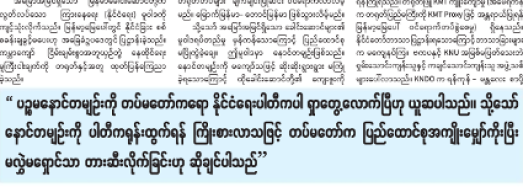
Articles featured in The Mirror and New Light of Myanmar put forward the regime’s interpretation of Myanmar’s political instabilities and attempt to justify both the coup and the military’s continued role in national politics One article, “Only Negotiation Can,” argued that the coup was staged due to election fraud, ignoring the fact that the election results have already been recognized by the international community. In “Important Lines of Regret for National Unity,” the author states that all military coups throughout history were undertaken only with rightful intentions to maintain national unity and sovereignty. Similarly, the article, “To Critically Look Forward to Myanmar’s Affairs,” claimed that the democratization process known as the “Myanmar Spring” was led by the military and is currently paused on account of the election fraud, although the junta planned to fully prioritize electoral politics and continuously contribute to nation-building.
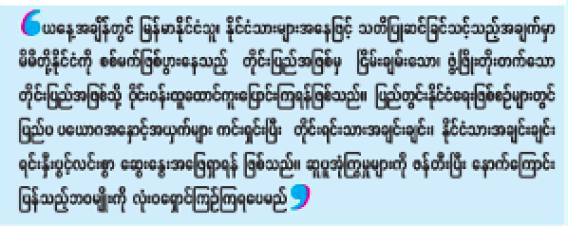
Likewise, as a counter-response to the Civil Disobedience Movement, articles such as “A Letter to My Sister” and “Contribute to the Nation by Improving Workplace Capacities” discourage readers from participating in the movement. This propaganda was spread in the form of reminders about rules and regulations applying to civil servants and their procedures, underscoring that they should always accomplish their work and requesting that they should not listen to agitators and neglect their duties. These articles underscore, in a threatening manner, that doing so can even affect their families and dependents. Other articles, such as “Bring Peace through Mindfulness,” and “The Beauty of Our Soul,” appeal to other values, asking citizens to maintain a high level of morality by refusing to join the protests.
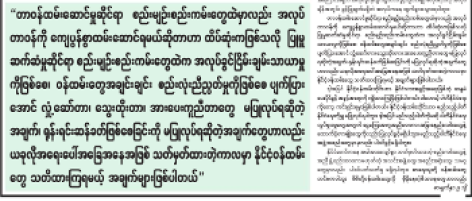
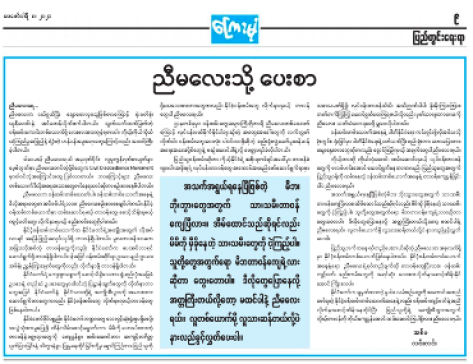
The local news section features the military junta’s cabinet ministers’ daily activities, comments on governmental issues, and COVID-19 updates. This section also tries to stimulate ethnic unity and Myanmar nationalism through the “74th Anniversary of Union Day’s objectives” and other slogans. The invitation to a pilgrimage to pay homage to the Shwedagon and Maha Myat Muni pagodas and reporting on military personnel’s cleaning of pagodas across the country clearly shows that the current military government is using religion to arouse nationalism and patriotism. In particular, high-ranking military officials’ donations and offerings to monasteries and nunneries amount to an effort to gain public support by means of religion.
Announcements that ethnic people and other civilians can receive healthcare services at the military hospitals—and that six non-military doctors have voluntarily joined military hospitals’ medical services—attempt to weaken the Civil Disobedience Movement (CDM) in the healthcare sector. Many articles also report union-level officials and senior government officers in Nay Pyi Taw getting COVID-19 vaccinations and describe the launching of a vaccination programme for elderly individuals over 65-years-old. These try to present a picture of normalcy, by showing that the vaccination procedures are carrying on amidst the Civil Disobedience Movement. Other news shows State Administration Council supporters taking to the streets in some townships of Mandalay and Bago.
In the international news section, updates on COVID-19 around the world and about vaccination processes are the most common news items. The donation of COVID-19 vaccines by China to other countries, as well as other China-related news, can occasionally be seen. Though not in the international news, we also studied a translated article relating to foreign affairs called “Long Lasting Friendship,” which includes exaggerated praise about Russia being a true friend to Myanmar, having assisted Myanmar militarily, politically, and financially even in the time of Western sanctions.
The military-owned Myawaddy newspaper mainly focuses on flag-waving propaganda in its editorial sections and in the military news, informing readers of the daily procedures of the military and their personnel, as well as the delivery of health care services in military hospitals. Some articles are also distributing misinformation by asserting cases of policemen injured in assaults by “disturbance-makers” while trying to subdue violent protesters, but not addressing myriad reports and evidence of police aggressively suppressing peaceful demonstrations.
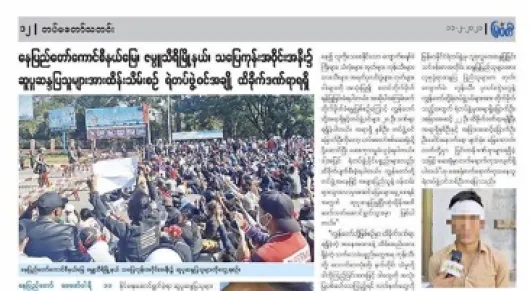
On the whole, through this study, we have found that that the military’s efforts to disseminate propaganda through the media outlets mentioned above target citizens with less political awareness and people who are not fully conscious about the contemporary political landscape. The most common topic that we found in these propagating activities is religion, and through religiously influential persons and themes, the military is trying to build up its image as an entity dedicated to religious development alongside nationalism and patriotism.
In addition, the State Administration Council tends to get public recognition as a legitimate government when media repeatedly uses the phrases “in accordance with the laws,” “democratic practices,” “eternal peace,” and so on, with this language set on proving that they can function well as a government body. However, one notable element is that, despite the military’s promise to prioritize electoral politics and democratize the nation as soon as possible, according to their speeches and articles, it is clear that they intend to merely implement a political system aligned with their interests that will strategically perpetuate some of the nation’s instabilities, which generally benefit the military.
Another component of the most prominent propaganda seeks to strengthen national unity by encouraging the engagement of ethnic minorities. While the military-owned Myawaddy newspaper describes its audience as “civilian citizens”, the Ministry of Information newspapers refer to it as “ethnic people and civilian citizens.” Furthermore, emphasizing the military’s community contributions in frontier regions and rural areas, including its aid to ethnic minorities and repeated statements of nationalist slogans imply that this propaganda targets not only the majority but also minorities.
To counter the nationwide Civil Disobedience Movement, the media publicized reminders and requests as a part of their propaganda efforts. Particularly common were accusations about healthcare workers’ lack of professionalism for taking part in CDM, frequent requests that civil servants return to their respective workplaces, and reminders that individuals’ refusal to work could impact their own family members. These underscore the in-depth consequences of this movement in terms of destabilizing bureaucratic mechanisms.
Studying the character and influence of media propaganda in Myanmar since the coup reinforces the importance of the press reporting only timely, up-to-date, and reliable news, and of citizens to educate each other about media literacy, sharing only accurate information. As follow-up research, analysis of the readers’ behavioural change and resultant opinions (the audience’s response is a limitation of this research) should be conducted to provide more comprehensive recommendations on the impacts of the propaganda mentioned above.
Contributors of this research article are six students of the International Relations Specialization from the University of Yangon, Myanmar.
Like This Article
June 10, 2024
April 09, 2024
March 20, 2024